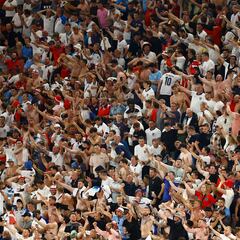Why is England’s national team called “The Three Lions”?
Lions feature on both the royal arms of England and Scotland but why those specific animals and where did the heraldry originate?

By now, most football fans, in Europe at least, will be familiar with the song Three Lions which was commissioned by the FA and penned by Lightning Seeds frontman Ian Broudie with lyrics by comedians Frank Skinner and David Baddiel. It was written specifically for Euro 96 which was held in England, 30 years after the country held, and won, the World Cup - to date, the one and only major tournament by the country which invented the Beautiful Game.
Broudie explained that he did not want to produce a song that was nationalistic but one that, in Baddiel’s words, provoked a “gentle, non-aggressive patriotism”. First adopted by fans during the Euro 96 semi-final against Germany and memorably sung by England’s victorious women’s team during Sarina Wiegman’s post-match press conference after this summer’s Euros, it features the refrain, “Three Lions on a shirt (it’s coming home, it’s coming)”. But when did Three Lions come to signify England’s national football teams?
Ready to get started in #EURO2024 Group C!
— England (@England) June 16, 2024
Why do England use lions in team crest?
Lions with various different attitudes (rampant, passant) feature on both the royal arms of England and Scotland. Royal emblems depicting lions were first used by Danish Vikings around the 5th Century and were likely responsible for introducing the symbol after they settled in England at the end of the 8th Century.
The 700 year old seal bag embroidered by the royal arms of England was made in 1280 CE.#archaeohistories pic.twitter.com/UFxSFetNnf
— Archaeo - Histories (@archeohistories) November 18, 2021
The Lion symbolises “courage, nobility, royalty, strength, stateliness and valour”. The first known appearance of the lion used in association with the English crown is a seal bearing two lions passant (walking with one paw raised), used by King Henry II’s son, John, at some point during his father’s reign from 1154 to 1189. John’s elder brother, Richard I (Richard the Lionheart), who succeeded his father on the throne, is believed to have been the first to have borne the arms of three lions passant-guardant during his 10-year reign from 1189 until his death in 1199. The three lions representing his status as King Richard I of England, Duke of Normandy and Duke of Aquitaine.
Related stories
Another theory is that the third lion was added to the crest after Henry’s marriage to French Queen Eleanor of Aquitaine in 1152 - the Angevin coat of arms features one gold lion passant on a red background.
#OnThisDay in 1872, @England met Scotland at Hamilton Crescent in football's first ever international fixture.
— Nat. Football Museum (@FootballMuseum) November 30, 2020
Players such as Arnold Kirke Smith turned out in these woollen jerseys in the goalless stalemate. It is thought to be the oldest surviving football shirt in existence. pic.twitter.com/G4lvIWSTzj
When did England crest feature three lions for the first time?
England’s national team kit first bore the now familiar crest featuring three lions during an international friendly against Scotland at Hamilton Crescent, Glasgow on 30 November 1872 - the first international friendly to be played anywhere in the world. Today, the England football team’s crest features three blue lions passant on a white background with 10 red Tudor roses which represent the regional branches of the Football Association.



Complete your personal details to comment